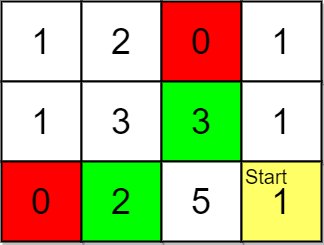LeetCode-in-Java
2146. K Highest Ranked Items Within a Price Range
Medium
You are given a 0-indexed 2D integer array grid of size m x n that represents a map of the items in a shop. The integers in the grid represent the following:
0represents a wall that you cannot pass through.1represents an empty cell that you can freely move to and from.- All other positive integers represent the price of an item in that cell. You may also freely move to and from these item cells.
It takes 1 step to travel between adjacent grid cells.
You are also given integer arrays pricing and start where pricing = [low, high] and start = [row, col] indicates that you start at the position (row, col) and are interested only in items with a price in the range of [low, high] (inclusive). You are further given an integer k.
You are interested in the positions of the k highest-ranked items whose prices are within the given price range. The rank is determined by the first of these criteria that is different:
- Distance, defined as the length of the shortest path from the
start(shorter distance has a higher rank). - Price (lower price has a higher rank, but it must be in the price range).
- The row number (smaller row number has a higher rank).
- The column number (smaller column number has a higher rank).
Return the k highest-ranked items within the price range sorted by their rank (highest to lowest). If there are fewer than k reachable items within the price range, return all of them.
Example 1:

Input: grid = [[1,2,0,1],[1,3,0,1],[0,2,5,1]], pricing = [2,5], start = [0,0], k = 3
Output: [[0,1],[1,1],[2,1]]
Explanation: You start at (0,0).
With a price range of [2,5], we can take items from (0,1), (1,1), (2,1) and (2,2).
The ranks of these items are:
-
(0,1) with distance 1
-
(1,1) with distance 2
-
(2,1) with distance 3
-
(2,2) with distance 4
Thus, the 3 highest ranked items in the price range are (0,1), (1,1), and (2,1).
Example 2:

Input: grid = [[1,2,0,1],[1,3,3,1],[0,2,5,1]], pricing = [2,3], start = [2,3], k = 2
Output: [[2,1],[1,2]]
Explanation: You start at (2,3).
With a price range of [2,3], we can take items from (0,1), (1,1), (1,2) and (2,1).
The ranks of these items are:
-
(2,1) with distance 2, price 2
-
(1,2) with distance 2, price 3
-
(1,1) with distance 3
-
(0,1) with distance 4
Thus, the 2 highest ranked items in the price range are (2,1) and (1,2).
Example 3:

Input: grid = [[1,1,1],[0,0,1],[2,3,4]], pricing = [2,3], start = [0,0], k = 3
Output: [[2,1],[2,0]]
Explanation: You start at (0,0).
With a price range of [2,3], we can take items from (2,0) and (2,1).
The ranks of these items are:
-
(2,1) with distance 5
-
(2,0) with distance 6
Thus, the 2 highest ranked items in the price range are (2,1) and (2,0).
Note that k = 3 but there are only 2 reachable items within the price range.
Constraints:
m == grid.lengthn == grid[i].length1 <= m, n <= 1051 <= m * n <= 1050 <= grid[i][j] <= 105pricing.length == 22 <= low <= high <= 105start.length == 20 <= row <= m - 10 <= col <= n - 1grid[row][col] > 01 <= k <= m * n
Solution
import java.util.Arrays;
import java.util.LinkedList;
import java.util.List;
import java.util.Queue;
public class Solution {
static class Item {
int row;
int col;
int dist;
int price;
public Item(int row, int col, int dist, int price) {
this.row = row;
this.col = col;
this.dist = dist;
this.price = price;
}
}
public List<List<Integer>> highestRankedKItems(
int[][] grid, int[] pricing, int[] start, int k) {
int n = grid.length;
int m = grid[0].length;
Queue<int[]> bfs = new LinkedList<>();
LinkedList<Item> items = new LinkedList<>();
bfs.add(start);
if (grid[start[0]][start[1]] >= pricing[0] && grid[start[0]][start[1]] <= pricing[1]) {
items.add(new Item(start[0], start[1], 0, grid[start[0]][start[1]]));
}
grid[start[0]][start[1]] = -1;
int distance = 0;
while (!bfs.isEmpty()) {
int size = bfs.size();
distance++;
while (size-- > 0) {
int[] loc = bfs.poll();
int[] dirX = {0, 1, -1, 0};
int[] dirY = {-1, 0, 0, 1};
for (int i = 0; i < 4; i++) {
int newX = loc[0] + dirX[i];
int newY = loc[1] + dirY[i];
if (newX < 0
|| newX >= n
|| newY < 0
|| newY >= m
|| grid[newX][newY] == -1
|| grid[newX][newY] == 0) {
continue;
}
if (grid[newX][newY] >= pricing[0] && grid[newX][newY] <= pricing[1]) {
items.add(new Item(newX, newY, distance, grid[newX][newY]));
}
grid[newX][newY] = -1;
bfs.add(new int[] {newX, newY});
}
}
}
items.sort(
(a, b) -> {
int distDiff = a.dist - b.dist;
if (distDiff == 0) {
int priceDiff = a.price - b.price;
if (priceDiff == 0) {
int rowDiff = a.row - b.row;
if (rowDiff == 0) {
return a.col - b.col;
}
return rowDiff;
}
return priceDiff;
}
return distDiff;
});
List<List<Integer>> ans = new LinkedList<>();
while (k-- > 0 && !items.isEmpty()) {
Item item = items.poll();
ans.add(Arrays.asList(item.row, item.col));
}
return ans;
}
}

